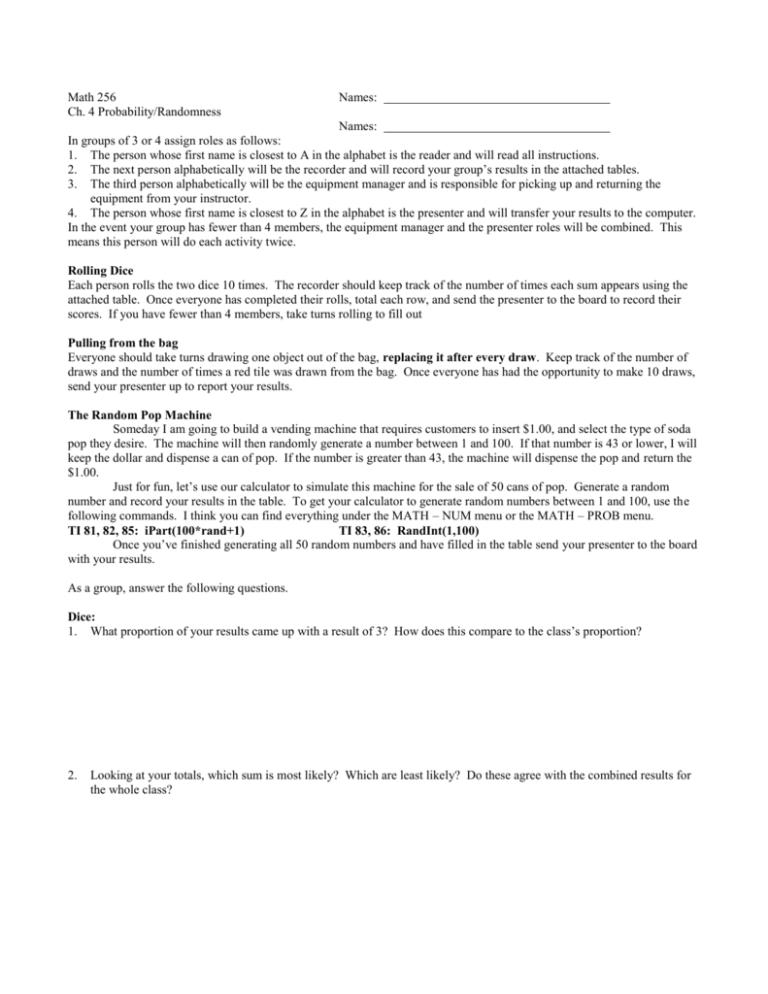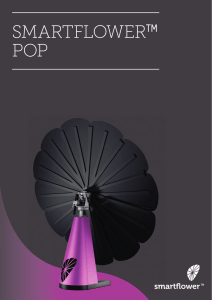BA/Math 256
advertisement

Math 256 Ch. 4 Probability/Randomness Names: Names: In groups of 3 or 4 assign roles as follows: 1. The person whose first name is closest to A in the alphabet is the reader and will read all instructions. 2. The next person alphabetically will be the recorder and will record your group’s results in the attached tables. 3. The third person alphabetically will be the equipment manager and is responsible for picking up and returning the equipment from your instructor. 4. The person whose first name is closest to Z in the alphabet is the presenter and will transfer your results to the computer. In the event your group has fewer than 4 members, the equipment manager and the presenter roles will be combined. This means this person will do each activity twice. Rolling Dice Each person rolls the two dice 10 times. The recorder should keep track of the number of times each sum appears using the attached table. Once everyone has completed their rolls, total each row, and send the presenter to the board to record their scores. If you have fewer than 4 members, take turns rolling to fill out Pulling from the bag Everyone should take turns drawing one object out of the bag, replacing it after every draw. Keep track of the number of draws and the number of times a red tile was drawn from the bag. Once everyone has had the opportunity to make 10 draws, send your presenter up to report your results. The Random Pop Machine Someday I am going to build a vending machine that requires customers to insert $1.00, and select the type of soda pop they desire. The machine will then randomly generate a number between 1 and 100. If that number is 43 or lower, I will keep the dollar and dispense a can of pop. If the number is greater than 43, the machine will dispense the pop and return the $1.00. Just for fun, let’s use our calculator to simulate this machine for the sale of 50 cans of pop. Generate a random number and record your results in the table. To get your calculator to generate random numbers between 1 and 100, use the following commands. I think you can find everything under the MATH – NUM menu or the MATH – PROB menu. TI 81, 82, 85: iPart(100*rand+1) TI 83, 86: RandInt(1,100) Once you’ve finished generating all 50 random numbers and have filled in the table send your presenter to the board with your results. As a group, answer the following questions. Dice: 1. What proportion of your results came up with a result of 3? How does this compare to the class’s proportion? 2. Looking at your totals, which sum is most likely? Which are least likely? Do these agree with the combined results for the whole class? Drawing from the bag 1. Calculate the probability of drawing out a red object using the class totals. 2. If you repeated the experiment 1000 times, how many times would you expect to get a red object? The Random Pop Machine 1. Explain why this pop machine would be attractive to consumers. Use all the concepts we have talked about in class. Be specific. 2. In order to make a profit of $0.15 per can, how much should the owner of the machine pay for each can of soda? 3. If the owner’s cost increased to $0.52 per can, how could the machine be modified to keep the owner’s profits at $0.15 per can? How would your changes affect public opinion of the machine? 4. Do you think the State Gambling Commission would find this machine to be a form of gambling? Explain your reasoning. Dice Sum Number of occurrences Number of occurrences Number of occurrences Number of occurrences Group Total 2 3 4 5 6 7 8 9 10 11 12 Drawing from the bag Draw 1 Draw 2 Person 1 Person 2 Person 3 Person 4 Draw 3 Draw 4 Draw 5 Draw 6 Draw 7 Number of Red Objects Number of Draws Pop Machine Cans Sold 1 2 3 4 5 6 7 8 9 10 11 12 13 14 15 16 17 18 19 20 21 22 23 24 25 Random Number Total $ Collected Cans Sold 26 27 28 29 30 31 32 33 34 35 36 37 38 39 40 41 42 43 44 45 46 47 48 49 50 Random Number Total $ Collected Draw 8 Draw 9 Draw 10






